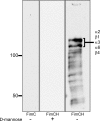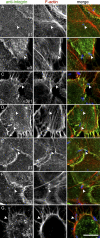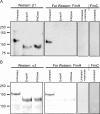Integrin-mediated host cell invasion by type 1-piliated uropathogenic Escherichia coli
- PMID: 17630833
- PMCID: PMC1914067
- DOI: 10.1371/journal.ppat.0030100
Integrin-mediated host cell invasion by type 1-piliated uropathogenic Escherichia coli
Abstract
Uropathogenic Escherichia coli (UPEC), the primary causative agent of urinary tract infections, typically express filamentous adhesive organelles called type 1 pili that mediate both bacterial attachment to and invasion of bladder urothelial cells. Several host proteins have previously been identified as receptors for type 1 pili, but none have been conclusively shown to promote UPEC entry into host bladder cells. Using overlay assays with FimH, the purified type 1 pilus adhesin, and mass spectroscopy, we have identified beta1 and alpha3 integrins as key host receptors for UPEC. FimH recognizes N-linked oligosaccharides on these receptors, which are expressed throughout the urothelium. In a bladder cell culture system, beta1 and alpha3 integrin receptors co-localize with invading type 1-piliated bacteria and F-actin. FimH-mediated bacterial invasion of host bladder cells is inhibited by beta1 and alpha3 integrin-specific antibodies and by disruption of the beta1 integrin gene in the GD25 fibroblast cell line. Phosphorylation site mutations within the cytoplasmic tail of beta1 integrin that alter integrin signaling also variably affect UPEC entry into host cells, by either attenuating or boosting invasion frequencies. Furthermore, focal adhesion and Src family kinases, which propagate integrin-linked signaling and downstream cytoskeletal rearrangements, are shown to be required for FimH-dependent bacterial invasion of target host cells. Cumulatively, these results indicate that beta1 and alpha3 integrins are functionally important receptors for type 1 pili-expressing bacteria within the urinary tract and possibly at other sites within the host.
Conflict of interest statement
Figures






References
-
- Foxman B, Brown P. Epidemiology of urinary tract infections: Transmission and risk factors, incidence, and costs. Infect Dis Clin North Am. 2003;17:227–241. - PubMed
-
- Foxman B, Barlow R, D'Arcy H, Gillespie B, Sobel JD. Urinary tract infection: Self-reported incidence and associated costs. Ann Epidemiol. 2000;10:509–515. - PubMed
-
- Ronald A. The etiology of urinary tract infection: Traditional and emerging pathogens. Am J Med. 2002;113(Suppl 1A):14S–19S. - PubMed
Publication types
MeSH terms
Substances
Associated data
- Actions
- Actions
- Actions
- Actions
- Actions
- Actions
- Actions
- Actions
Grants and funding
LinkOut - more resources
Full Text Sources
Other Literature Sources
Miscellaneous

